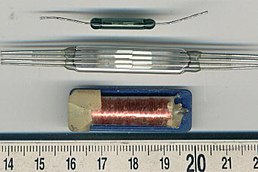


The reed switch[i] is an electromechanical switch operated by an applied magnetic field. It was invented in 1922 by professor Valentin Kovalenkov at the Petrograd Electrotechnical University,[1] and later evolved at Bell Telephone Laboratories in 1936 by Walter B. Ellwood into the reed relay. In its simplest and most common form, it consists of a pair of ferromagnetic flexible metal contacts in a hermetically sealed glass envelope. The contacts are usually normally open, closing when a magnetic field is present, or they may be normally closed and open when a magnetic field is applied. The switch may be actuated by an electromagnetic coil, making a reed relay,[2] or by bringing a permanent magnet near it. When the magnetic field is removed, the contacts in the reed switch return to their original position. The "reed" is the metal part inside the reed switch envelope that is relatively thin and wide to make it flexible, resembling the reed of a musical instrument. The term "reed" may also include the external wire lead as well as the internal part.[i]
A common example of a reed switch application is to detect the opening of a door or windows, for a security alarm.[3]
Cite error: There are <ref group=lower-roman> tags or {{efn-lr}} templates on this page, but the references will not show without a {{reflist|group=lower-roman}} template or {{notelist-lr}} template (see the help page).
- ^ Cite error: The named reference
IEEE_Reed_relay_historywas invoked but never defined (see the help page). - ^ Cite error: The named reference
Graf_1975was invoked but never defined (see the help page). - ^ Platt, Charles (2012-10-26). Encyclopedia of electronic components. Sebastopol, CA. p. 17. ISBN 978-1-4493-3389-8. OCLC 855977865.
{{cite book}}: CS1 maint: location missing publisher (link)